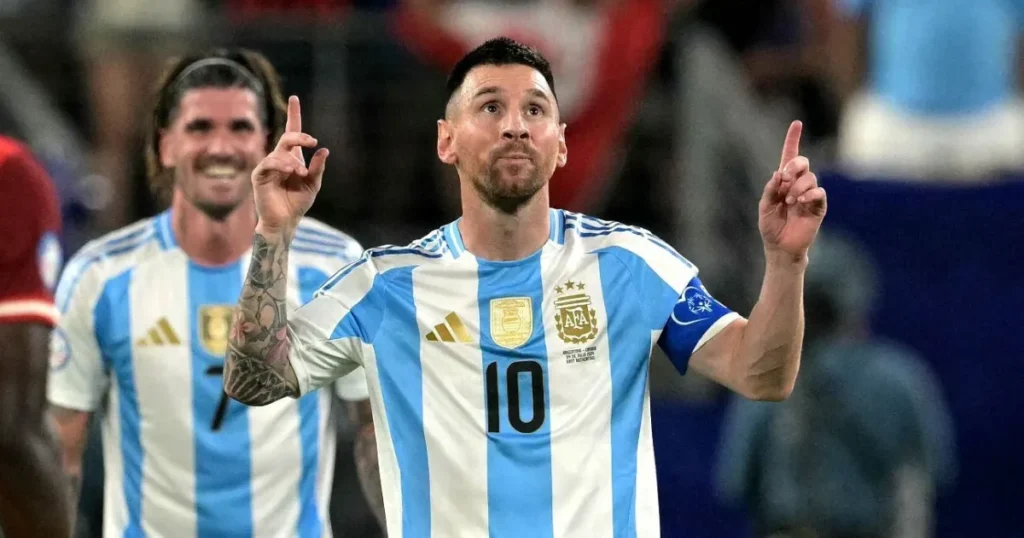The Argentina national football team, often hailed as one of the most storied sides in the beautiful game, embodies the fiery spirit of a nation where football isn’t just a sport—it’s a religion. Known affectionately as La Albiceleste (The White and Sky Blue), this squad has captivated the world with its blend of technical brilliance, dramatic flair, and unyielding determination. From the sun-drenched pitches of Buenos Aires to the global stage of the FIFA World Cup, the Argentina football team has scripted tales of triumph that resonate far beyond the final whistle.
As of November 2025, the Argentina FIFA ranking sits at a formidable second place, just behind Spain, after holding the top spot for over two years following their 2022 World Cup conquest. This positioning underscores their dominance in CONMEBOL qualifiers, where they’ve already secured a spot for the 2026 tournament. Whether you’re a die-hard fan or a newcomer drawn in by the magic of Lionel Messi, diving into the Argentina national football team games reveals a rich tapestry of history, heroes, and heart-pounding moments. Let’s lace up and explore what makes this team an eternal force.
A Storied History: From Humble Beginnings to Global Icons
The roots of the Argentina football team trace back to the late 19th century, when British expatriates introduced the sport to the ports of Buenos Aires. The first official match came in 1901 against Uruguay, but it was the 1908 debut of the iconic light blue and white striped jersey—worn in a 6-0 thrashing of Uruguay—that cemented their identity. Early on, the team flourished in regional competitions, clinching the precursor to the Copa América in 1910.
The 1920s and 1930s marked Argentina’s golden dawn in South American football. They dominated the South American Championship (now Copa América), winning titles in 1921, 1925, and 1927. Stars like Manuel Seoane and Antonio Sastre dazzled with their elegant, improvisational style—a “criollo” flair that prioritized creativity over rigid British discipline. Yet, international success eluded them initially; boycotts kept them out of the first three World Cups, including the 1930 final hosted by Uruguay.
Post-World War II, Argentina roared back. Guillermo Stábile, the team’s all-time leading coach in matches (127 games), steered them to six South American titles between 1941 and 1957. The 1950s brought Olympic gold in 1956, but it was the 1978 World Cup on home soil that ignited national euphoria. Under César Luis Menotti, a 3-1 extra-time victory over the Netherlands crowned them champions for the first time. Mario Kempes’ six goals made him the tournament’s hero.
The 1980s belonged to Diego Maradona. His 1986 World Cup masterclass—infamously including the “Hand of God” and the “Goal of the Century” against England—delivered a 3-2 final win over West Germany. These moments weren’t just victories; they were cultural touchstones, healing a nation scarred by dictatorship. The 1990s and early 2000s were leaner, with finals losses in 1990 and three straight Copa Américas (1993, 1998, 2007). But the arrival of Lionel Messi in 2005 sparked a new era.
Under coaches like Alejandro Sabella and Jorge Sampaoli, Argentina reached three consecutive World Cup finals (2014, but wait—2014 loss to Germany, 2015 and 2017 Copa finals). The drought ended spectacularly in 2021 with Copa América glory, followed by the 2022 World Cup triumph over France on penalties—Messi’s crowning jewel. By 2024, they’d added another Copa América, making Lionel Scaloni the architect of a modern dynasty. Today, the Argentina football team stands as a symbol of resilience, with 23 official titles, the most in men’s international football.
Major Achievements: Trophies That Echo Through Generations
Few teams can match the Argentina national football team’s trophy cabinet. Their three FIFA World Cup wins (1978, 1986, 2022) place them alongside powerhouses like Italy and Germany. The 2022 edition, where Messi scored seven goals and lifted the trophy in Lusail, was poetic justice after years of near-misses.
In the Copa América, they’ve reigned supreme with 16 titles, tied with Uruguay—their fiercest rivals. Recent back-to-back wins in 2021 and 2024 highlight their regional stranglehold. Add two Olympic golds (2004, 2008) for the U-23 side, the 1992 Confederations Cup, and two Finalissimas (1993, 2022), and it’s clear why La Albiceleste is synonymous with excellence.
To better understand their dominance, here’s a comprehensive table of major achievements:
| Tournament | Titles Won | Years Won | Notable Highlights |
|---|---|---|---|
| FIFA World Cup | 3 | 1978, 1986, 2022 | Messi’s 2022 triumph; Maradona’s 1986 magic |
| Copa América | 16 | 1921, 1925, 1927, 1929, 1937, 1941, 1945–47, 1955, 1957, 1959, 1991, 1993, 2021, 2024 | Back-to-back wins under Scaloni |
| Olympic Gold (U-23) | 2 | 2004, 2008 | Messi captained 2008 squad |
| FIFA Confederations Cup | 1 | 1992 | Inaugural edition victory |
| Finalissima (CONMEBOL-UEFA) | 2 | 1993, 2022 | 2022 win over Italy |
| Pan American Championship | 1 | 1960 | Early continental success |
This table not only showcases their haul but also illustrates the depth of their legacy—spanning decades and formats. It’s a visual roadmap for fans eager to grasp why the Argentina football team remains a benchmark for success.
Key Players: Legends and Rising Stars Lighting the Path
The Argentina national football team has always been powered by transcendent talents. Diego Maradona’s genius in the 1980s turned games into art, while Lionel Messi’s 114 goals (and counting) in 194 caps make him the all-time leading scorer. At 38, Messi remains the talisman, his vision and free-kick wizardry as sharp as ever in Inter Miami’s colors.
Current skipper Emiliano “Dibu” Martínez anchors the goal with heroic saves, earning back-to-back Yashin Awards. In midfield, Enzo Fernández’s box-to-box energy and Alexis Mac Allister’s composure provide the engine room. Up top, Lautaro Martínez’s predatory instincts (Inter’s Serie A star) complement Julián Álvarez’s explosive pace from Manchester City.
The bench brims with promise: Alejandro Garnacho’s Manchester United flair, Franco Mastantuono’s teenage creativity at Real Madrid, and Lisandro Martínez’s defensive steel at Manchester United. Veterans like Nicolás Otamendi and Ángel Di María add grit and guile. This blend of experience and youth ensures the Argentina football team stays ahead of the curve.
Tactics Under Lionel Scaloni: Balance, Flexibility, and Messi Magic
Lionel Scaloni, appointed interim in 2018, has evolved into a tactical maestro. His Argentina thrives on a fluid 4-3-3 or 4-4-2 diamond, emphasizing high pressing and quick transitions. Out of possession, they form compact layers—a rigid GK-4-1-3-2 block—to stifle opponents, recovering the ball high via aggressive counter-pressing.
In attack, Scaloni maximizes Messi’s freedom, often dropping him deeper to orchestrate. Wingers like Garnacho hug the touchline for width, while midfielders like Fernández break lines with vertical passes. Full-backs (Nahuel Molina, Lisandro Martínez) overlap dynamically, blending defensive solidity with attacking thrust. Against Ecuador in qualifiers, this setup yielded a 1-0 grind-out win, showcasing adaptability.
Scaloni’s genius lies in mentality: he fosters unity, rotating seamlessly without disrupting rhythm. It’s “La Nuestra” reborn—elegant yet pragmatic—proving why they’ve won three straight majors.
Recent Results: Momentum Building Toward 2026
The Argentina football team’s 2025 has been a qualifiers’ clinic, blending dominance with experimentation. They topped CONMEBOL with 35 points from 16 games, clinching qualification in March after a 4-1 demolition of Brazil—Lautaro’s brace stealing the show.
Key 2025 highlights include a 5-0 rout of Bolivia in October (Messi’s hat-trick), a gritty 1-0 over Ecuador, and a 2-2 draw with Paraguay that tested resolve. Friendlies against Venezuela (3-0) and Puerto Rico (4-1) in October gave youth like Mastantuono minutes. A shocking 2-1 loss to Uruguay in qualifiers was a rare blip, but they’ve won 12 of 14, scoring 38 goals while conceding just 8.
These results affirm their Argentina FIFA ranking resilience—slipping to second but unbeaten in 10 straight as of November.
| Date | Opponent | Result | Competition | Key Moment |
|---|---|---|---|---|
| March 25, 2025 | Brazil | 4-1 | WC Qualifier | Lautaro Martínez double |
| Sept 9, 2025 | Venezuela | 3-0 | WC Qualifier | Álvarez’s opener |
| Oct 10, 2025 | Bolivia | 5-0 | WC Qualifier | Messi’s hat-trick |
| Oct 14, 2025 | Puerto Rico | 4-1 | Friendly | Garnacho’s debut goal |
| Oct 15, 2025 | Ecuador | 1-0 | WC Qualifier | Otamendi’s late winner |
This table highlights recent form, helping readers track the highs (and that one hiccup) fueling their fire.
Upcoming Fixtures: Eyes on the Argentina Next Match and Beyond
With qualifiers wrapped, 2025’s tail end focuses on tune-ups. The Argentina next match is November 15 against Angola in Luanda—a African friendly to test depth against physicality. Followed by a November 19 clash with the USA in Qatar, it’s a high-stakes prep for 2026.
2026 brings the World Cup (June 11–July 19 across USA, Mexico, Canada), where they’ll defend as favorites. Expect group-stage fireworks, possibly against European heavyweights. Post-World Cup, a 2027 Copa América looms. Scaloni’s schedule: friendlies in Asia (China, Japan?) early 2026 for rotation.
Mark your calendars—these games will shape La Albiceleste‘s quest for back-to-back glory.
Fan Culture: The Soul of Argentine Passion
Argentine football pulses with fervor. Streets empty during matches; families bond over choripán (chorizo sandwiches) at bombas (street grills) near stadiums. Chants like “¡Vamos, vamos Argentina!” or “¡Olé, olé, olé, olá!” unite generations, while the banderazo—pre-match flag-waving rallies—turns cities into seas of blue and white.
Barras bravas, the hardcore ultras, bring raw energy but also controversy—violence led to away-fan bans since 2013. Yet, their murals honoring Maradona (a near-deity) and Messi foster unity. Women-led groups like Hinchadas Argentinas challenge norms, proving football’s inclusivity. Globally, diaspora fans paint Times Square Albiceleste during tours, exporting this electric vibe.
It’s this devotion—poetic, chaotic, profound—that makes supporting the Argentina football team feel like living a legend.
Future Outlook: Defending Glory in 2026 and Beyond
As 2026 nears, optimism abounds for the Argentina national football team. Already qualified, they’ll enter as title holders in Messi’s probable swan song—his hinted participation hinges on fitness, but at 38, he’s plotting one last heist. Scaloni’s contract runs through the tournament, blending veterans (Messi, Di María) with phenoms (Mastantuono, Garnacho).
Challenges? Depth post-Messi and injury risks loom, but their 2025 form (unbeaten streak intact) and tactical evolution position them for contention. Analysts peg them top-five favorites, behind Spain and France. Beyond 2026, youth pipelines from River Plate and Boca Juniors promise sustained excellence—aiming for a fourth World Cup star.
In a 48-team format, anything’s possible, but La Albiceleste‘s blend of heart and skill suggests more magic. The future? As vibrant as a Buenos Aires sunset, with the world watching.
The Argentina football team isn’t just playing games—they’re weaving dreams. From historic highs to horizon-bound hopes, their journey inspires. What’s your favorite moment? Share in the comments, and let’s keep the passion alive. ¡Vamos Argentina!






